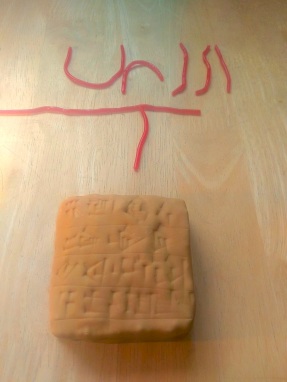
This is, obviously, a continuation from my previous timeline of the invention of writing. You could link them up, if you wanted. Of course, that one had dates, whereas this one has period names. Maybe I thought period names were more appropriate, since these tablets are always by known by their period, and never by their dates. Perhaps I ate too many of the strawberry laces to write out the dates. Perhaps that would also explain why the period names are abbreviated, as opposed to written in full. Perhaps it will always remain a mystery.

So, starting with this nice little little archaic Ur text, from the Early Dynastic I-II period. The large, most obvious signs are the number signs: they still look like the Uruk period ones. And although there are some wedge shaped signs, there are still some with rounded shapes.

Then we move to the Early Dynastic IIIa. Here’s a copy of a lovely, if slightly broken, tablet from the city of Shuruppak. Notice how the number signs are still impressed in the same archaic as the Uruk and Early Dynastic I-II tablets, but that all the rest of the signs are now the nice, traditional wedge shape. I can attest to the fact that making the signs out of impressed wedges is a much quicker way to write than drawing them out. At least on fondant-ed cakes.

This is the next stage: a tablet from Early Dynastic IIIb Girsu. Again, the number signs are still nice and archaic, and probably impressed with the end of the stylus.
By the way, this tablet is exciting for another reason as well: This is one of the first texts that references a measurement of grain called the ‘gur sag-gal’ (poorly written, in the top left hand corner).
Hmm. It’s possible that that particular fact was only exciting to me. I study ancient systems of measurement, and if we’re being honest I lost track of what other people find interesting a long time ago. Does it show?

And then we come to the Old Akkadian period. The Akkadian kings brought numerous changes to the writing systems and the tablets (and to metrology…). As here, the tablets are much more rectangular, and the number signs are at last written with wedges, as opposed to impressed with the end of the stylus (all of the lines on this tablet except for the top one begin with numbers).

And finally, we come to the uninspiringly titled Ur III period. It’s the ugliest name: flat, unimpressive, and when you say it in conversation to non-Assyriologists they stare at you blankly and make you wish that you studied something that included the word ‘Babylonian’. But it’s tablets are the best. This one here is a little receipt for a quantity of silver.
Incidentally, Moudhy al-Rashid posts wonderful stuff on twitter under the caption ‘cuneiform is beautiful’. And she’s right, it really can be:
Shiny diorite stele with precise, even signs or huge cylinders with tiny writing covering them completely are very visually appealing (Moudhy’s photography skills help too). But as far as I’m concerned, the scrappy, ugly little tablets are the best bits of Assyriology. They’re the most human of ancient artefacts: tax records, scribbled receipts, bickering letters. Their ugliness is part of their charm, a demonstration of the fact that their contents are all that anyone cared about, and an attestation to their honesty.
Royal inscriptions and the like can be stunning and well written, but they’re also riddled with lies, exaggerations and nonsense. But look at that Ur III tablet (or at least, at its cake-replica). Because of that tablet we know, with absolute certainty, that a man called Basaga gave another man called Akalla 43g of silver in the 33rd regnal year of King Shulgi, over 4,000 years ago. The precision and undimmed truthfulness of that kind of knowledge astounds me ever time. And then I make it out of cake.
The Ur III texts have another, wonderful bonus: they’re the perfect, fondant-fancy size for mid-afternoon tea. 
Points if you can guess what book I’m reading. Points in the form of cake. Seriously, I’m producing a lot of cake. Would anyone like some?

Any time you want to come visit the Cambridge Faculty of Classics you will find many people there to help you eat cake shaped like ancient inscriptions 🙂
LikeLiked by 1 person
I do most of my baking in London, so I might take you up on that offer when I next make something truly gigantic! If I can get through the train ride without eating it all myself.
LikeLiked by 1 person
We also do quite a bit of baking of our own… 🙂
LikeLike
I know, it’s amazing! I love your blog. We should have an ancient history themed bake off!
LikeLiked by 1 person
Sounds great to me!
LikeLiked by 1 person